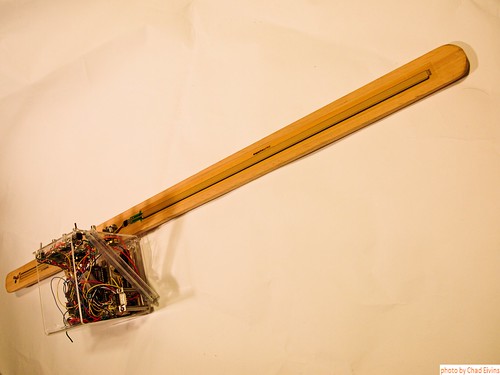The Double Ribbon
First a word about the name. I’ll admit that I try for clever allusions in the names for my creations. But that ploy doesn’t always pan out in reality. For this controller I tried several working titles (ie ‘The Popsicle Stick’). But none of them ever stuck. For a long time this controller was simply ‘The Ribbon’. Then, as other ribbon controllers emerged from the workshop, qualifying terms had to be added. This one has two separate ribbons so it became ‘The Double Ribbon’
A ribbon controller is a not a novel idea, nor a complex one. The Ondes Martenot & Trautonium both employed ribbon controllers in the 1920’s and Moog sold one as a standard item in the 1960’s. The idea is simple. You touch a ribbon, anywhere along it’s length , and it outputs a gate, and a voltage that corresponds to the point at which your finger makes contact with the ribbon. Its very similar to playing an acoustic stringed instrument. I have been a string player since childhood my first string instrument was ‘cello and then bass guitar. I practice with some string instrument daily and those instruments are what I consider ‘home’.
The resemblance is hardly surprising. The playing position of the Double Ribbon when it’s strapped around my neck is completely natural and effortless for me. This controller has become a common default controller for my large-scale ‘science-fair-table’ analog improvisations. In live performance it’s, pretty much, my main axe. In live performance I tend to refrain from twisting a lot of knobs. There are several reasons for this rather unusual eschewment but that’s outside the scope of this article. Suffice to say I prefer instead to map a lot of parameters to a limited number of control vectors on a single controller. So to fill this role, the Double Ribbon has to provide a hell of a lot more than just 2 ribbons with a gate & control voltage each. The Double Ribbon does provide those 4 outputs but it outputs a LOT more in addition. All of these outputs are routed to a 12-foot multi-conductor cable (seen in top photo). On the other end of the cable there is a breakout box with 1/8″ jacks for all the outputs. The block diagram below illustrates the big picture. It is very complex. And even though I use this controller more than any other. I have to use notes to remind myself how it works every time I design a performance with it. I am not going to attempt an exhaustive description of every function in this article. But I will touch on a few highlights below
The Long Ribbon:
The longer ribbon features a variable width zone that that contains three non-overlapping zones with boundaries set by 3 on-board knobs. When Zone 1 is touched, a CV reversed from the default direction of the long ribbon is output. When Zone 2 is touched a random sampled CV is added to the ribbon CV output. When Zone 3 is touched a rising ramp that is trigged by a function of the Short Ribbon is added to the ribbon CV output.
The Short Ribbon:
The shorter ribbon has a metal guitar string suspended above it. You can see the tuning machine that sets this wire’s tension in the photo below at the lower end of the controller. When touched, this wire triggers multiple functions. One of which is the ramp used by Zone 3 on the Long Ribbon.
Another is a sort of velocity-driven envelope generator. Since the wire is above the surface of the Short Ribbon, contact is always made with the wire BEFORE the ribbon itself. The interval of time between contact with the wire and contact with the ribbon is used to derive a control voltage that is used to impose lag on the Short Ribbon’s gate. So a slow press will create a long attack and decay, proportional to the ‘slowness’ of the press, and a quick , sharp press will impose negligible lag on the gate.
Put all these outputs together and there’s plenty of CV’s & gates under my fingers to make lots of mischief without having to find the right knob to twist in a dim field of 70 other identical knobs on a stage that the lighting tech decided would look cooler if it was ‘moodily dark’. (sorry lighting techs…I know you’re just trying to put on a good show too!)






Comments are closed.